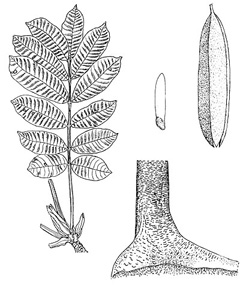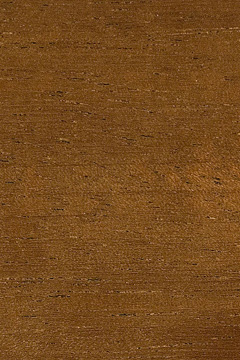 |
|
prota.org |
 |
| Jean-Pierre Chéreau & Roger Culos |
Translate this page:
Summary
Entandrophragma candollei or West African Cedar is a deciduous large tree growing about 50 m in height. It is slow-growing with the usually straight and cylindrical bole of up to 4 m in diameter. It is often buttressed and can be branches for up to 30 m. The bark is used in traditional medicine particularly as an anodyne and for snake bites. The wood is used in the production of sliced veneer, for construction, joinery, boat building, furniture, cabinetwork, flooring, plywood, etc.
Physical Characteristics

 Entandrophragma candollei is a deciduous Tree growing to 50 m (164ft) by 30 m (98ft) at a slow rate.
Entandrophragma candollei is a deciduous Tree growing to 50 m (164ft) by 30 m (98ft) at a slow rate.
See above for USDA hardiness. It is hardy to UK zone 10. The plant is not self-fertile.
Suitable for: light (sandy), medium (loamy) and heavy (clay) soils and prefers well-drained soil. Suitable pH: mildly acid, neutral and basic (mildly alkaline) soils. It cannot grow in the shade. It prefers moist soil.
UK Hardiness Map
US Hardiness Map
Synonyms
Entandrophragma choriandrum Harms Entandrophragma ferrugineum A.Chev.
Plant Habitats
Edible Uses
References More on Edible Uses
Medicinal Uses
Plants For A Future can not take any responsibility for any adverse effects from the use of plants. Always seek advice from a professional before using a plant medicinally.
Anodyne Parasiticide
The bark is used in traditional medicine[ 299 ]. The sap of the bark is applied externally as an anodyne[ 299 ]. The sap of the root bark is applied to snakebites[ 299 ]. The limonoids prieurianin and epoxyprieurianin have been isolated from the bark. These compounds and their acetates exhibited strong antifeedant activity against the gram pod borer Helicoverpa armigera[ 299 ]. Atomasin A and atomasin B are other limonoids that have been isolated. The first compound showed moderate in-vitro inhibitory activity against chloroquine-resistant strains of Plasmodium falciparum[ 299 ]. The triterpenoid methyl angolensate has been isolated from the roots[ 299 ].
References More on Medicinal Uses
The Bookshop: Edible Plant Books
Our Latest books on Perennial Plants For Food Forests and Permaculture Gardens in paperback or digital formats.

Edible Tropical Plants
Food Forest Plants for Hotter Conditions: 250+ Plants For Tropical Food Forests & Permaculture Gardens.
More

Edible Temperate Plants
Plants for Your Food Forest: 500 Plants for Temperate Food Forests & Permaculture Gardens.
More

More Books
PFAF have eight books available in paperback and digital formats. Browse the shop for more information.
Shop Now
Other Uses
Furniture Insecticide Parasiticide Wood
Other Uses: The heartwood is dull brown to dark purplish brown, slightly darkening upon exposure; it is distinctly demarcated from the 4 - 8cm wide band of greyish white to pale brown sapwood. The grain is straight to slightly interlocked; the texture coarse and even. The wood is moderately heavy; soft to moderately hard; it is moderately durable, being susceptible to powder-post beetle, pinhole borer and marine borer attacks, moderately resistant to termites and fungi, and resistant to dry wood borers. It seasons somewhat slowly with a high risk of distortion; once dry it is stable in service. The wood saws fairly easily although it requires some power, and it works easily with both hand and machine tools. It usually contains silica (up to 0.5%) and has moderate blunting effects on cutting edges; stellite-tipped saw teeth and tungsten-carbide cutting edges are recommended. In planing and moulding operations a 15 - 20° cutting angle is recommended, especially when interlocked grain is present. It can be finished to a nice surface, but the use of a filler may be required. The wood is not liable to splitting on nailing and screwing, and has good holding properties. The glueing, staining and polishing properties are good when a filler is used. The wood is suitable for the production of sliced veneer. The wood is used for construction, exterior and interior joinery, boat building, furniture, cabinetwork, high class furniture, veneer and plywood. It is suitable for flooring, interior trim, vehicle bodies, toys, novelties, boxes, crates and turnery[ 299 , 848 ].
Special Uses
References More on Other Uses
Cultivation details
A plant of the moist tropics, found mainly in areas where the mean annual rainfall is in the region of 1,800mm[ 299 ]. Under natural conditions, an average annual diameter increment of 5.1 mm has been recorded[ 299 ]. In plantations in Guinea trees reached a mean height of 2.7 metres after 6 years[ 299 ]. Trees start fruit production at larger bole diameters, and this has implications for forest management; harvesting trees of less than 50 cm bole diameter seriously reduces fruit production[ 299 ]. Trees can become very old; for the largest specimens ages of up to nearly 1000 years have been suggested[ 299 ].
References Carbon Farming Information and Carbon Sequestration Information
Temperature Converter
Type a value in the Celsius field to convert the value to Fahrenheit:
Fahrenheit:
The PFAF Bookshop
Plants For A Future have a number of books available in paperback and digital form. Book titles include Edible Plants, Edible Perennials, Edible Trees,Edible Shrubs, Woodland Gardening, and Temperate Food Forest Plants. Our new book is Food Forest Plants For Hotter Conditions (Tropical and Sub-Tropical).
Shop Now
Plant Propagation
Seed - fresh seeds start to germinate 1 week after sowing and the germination rate is 60 - 75%[ 299 ]. Seedling growth is slow, with a plant height of 13 cm after 5 months and 20 - 30 cm after 1 year. Seedlings are very sensitive to sun-scald and have to stay under permanent shade in the nursery[ 299 ]. For at least 2 - 3 years after being planted out the seedlings need slight shade to avoid high mortality, for example by a cover of a young secondary forest[ 299 ]. Natural regeneration is often scarce in natural forest, but gaps created by logging operations may promote regeneration. In natural forest, saplings are most common in gaps[ 299 ].
Other Names
If available other names are mentioned here
West African Cedar
Native Range
AFRICA: Cameroon, Democratic Republic of the Congo, Gabon, Equatorial Guinea, Côte D‘Ivoire, Ghana, Guinea, Liberia, Nigeria
Weed Potential
Right plant wrong place. We are currently updating this section.
Please note that a plant may be invasive in one area but may not in your area so it's worth checking.
Conservation Status
IUCN Red List of Threatened Plants Status : Status: Vulnerable A1cd

Growth: S = slow M = medium F = fast. Soil: L = light (sandy) M = medium H = heavy (clay). pH: A = acid N = neutral B = basic (alkaline). Shade: F = full shade S = semi-shade N = no shade. Moisture: D = dry M = Moist We = wet Wa = water.
Now available:
Food Forest Plants for Mediterranean Conditions
350+ Perennial Plants For Mediterranean and Drier Food Forests and Permaculture Gardens.
[Paperback and eBook]
This is the third in Plants For A Future's series of plant guides for food forests tailored to
specific climate zones. Following volumes on temperate and tropical ecosystems, this book focuses
on species suited to Mediterranean conditions—regions with hot, dry summers and cool, wet winters,
often facing the added challenge of climate change.
Read More
Expert comment
Author
Harms
Botanical References
1
Links / References
For a list of references used on this page please go here
A special thanks to Ken Fern for some of the information used on this page.
Readers comment
| Add a comment |
|
If you have important information about this plant that may help other users please add a comment or link below. Only comments or links that are felt to be directly relevant to a plant will be included. If you think a comment/link or information contained on this page is inaccurate or misleading we would welcome your feedback at [email protected]. If you have questions about a plant please use the Forum on this website as we do not have the resources to answer questions ourselves.
* Please note: the comments by website users are not necessarily those held by PFAF and may give misleading or inaccurate information.
To leave a comment please Register or login here All comments need to be approved so will not appear immediately.
|
Subject : Entandrophragma candollei
|
|
|
|